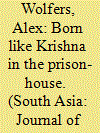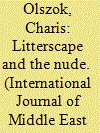| Srl | Item |
| 1 |
ID:
147199


|
|
|
|
|
| Summary/Abstract |
The revolutionary thinker and later yogi of Pondicherry, Aurobindo Ghose (1872–1950), played a critical role during the Swadeshi movement in Bengal, articulating a radical vision that determined the limits and possibilities of the Indian political. Reading his polemical journalism in Bande Mataram alongside his prison memoir, Karakahini, reveals the importance of the jail for his staging of politics. This paper refutes the usual dichotomy of politics and spirituality in readings of Aurobindo and instead explores their underlying interconnectedness in relation to his scripting of an insurrectionary and universalist Hindu metaphysics in which divinity intervened in human history on the side of the oppressed. Aurobindo's central symbol—of Krishna being born in a prison cell—inscribed enduring theo-political significance into the colonial jail, which was successfully re-imagined as a revolutionary ashram, a transformative and sovereign space where political prisoners could be reborn.
|
|
|
|
|
|
|
|
|
|
|
|
|
|
|
|
| 2 |
ID:
164745


|
|
|
|
|
| Summary/Abstract |
Mansur Bushnaf's al-ʿIlka (Chewing Gum; 2008) is the author's sole novel, born of his twelve-year imprisonment in a Libyan jail, and his reflection on the nation's subjection to international marginalization and dictatorial rule under Gaddafi. The novel is centered on a 19th-century nude which confounds all who encounter it, and which lies neglected in a corner of Tripoli's Red Palace Museum. Through this statue, and the novel's broader poetics of stasis and “chewing,” I explore how turāth in Bushnaf's work, and wider Libyan fiction, is depicted through its abject vulnerability and exposure to historical vicissitudes, reflecting the parallel exclusion of human lives from rights and agency. In al-ʿIlka, I examine how this is formulated into a defamiliarizing perspective on the postmodern, and on historical trauma and erasure, in which the possibility of narrative is a driving concern, rooted in existential reflection, as well as the real precarity of those who tell stories in Libya.
|
|
|
|
|
|
|
|
|
|
|
|
|
|
|
|